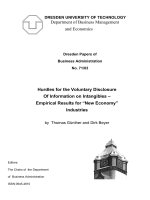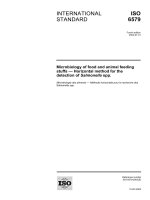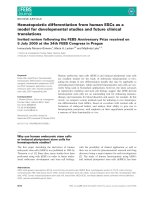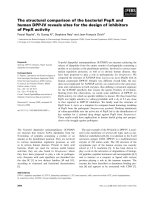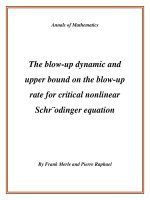SYMMETRIC EXISTENCE RESULTS, AND AGGREGATED, TOWERING BLOW UP SEQUENCES FOR THE PRESCRIBED SCALAR CURVATURE EQUATION ON SN
Bạn đang xem bản rút gọn của tài liệu. Xem và tải ngay bản đầy đủ của tài liệu tại đây (1.12 MB, 185 trang )
SYMMETRIC EXISTENCE RESULTS, AND
AGGREGATED, TOWERING BLOW-UP
SEQUENCES FOR THE PRESCRIBED
SCALAR CURVATURE EQUATION ON S N
ZHOU FENG
(B.Sc., Nankai University, P. R. China)
A THESIS SUBMITTED
FOR THE DEGREE OF DOCTOR OF PHILOSOPHY
DEPARTMENT OF MATHEMATICS
NATIONAL UNIVERSITY OF SINGAPORE
2015
DEDICATION
This thesis is dedicated to my late father Zhou Baoping.
His words of inspiration and encouragement in pursuit of excellence,
still linger on.
Acknowledgements
The completion of this PhD thesis has been a long journey. I would like to take
this opportunity to extend my utmost appreciation to the people who have encouraged and supported me throughout the process of writing this thesis.
My heartfelt and profoundest gratitude goes first and foremost to Professor Leung Man Chun, my supervisor, for his constant encouragement and enlightening
guidance that have significantly helped me in uniting this thesis, and his enthusiasm and immense knowledge that have inspired me throughout my graduate studies.
I have been extremely lucky to have a supervisor who cared so much about my research. I deeply appreciate his insightful guidance, valuable advice and periodic
constructive suggestions. Without his consistent and illuminating instruction, this
thesis could not have reached its present form. Studying under his guidance is an
enjoyable, exhilarating and rewarding experience.
I would like to thank the Department of Mathematics at the National University
of Singapore, especially those members of the Thesis Defense Committee, Professor
Chua Seng Kee and Professor Xu Xingwang, for their input, valuable discussions
and accessibility. Deepest gratitude is also due to committee member, Professor
vii
viii
Acknowledgements
Daniel Burns, for his expertise, patience and generous help.
I owe my sincere gratitude to my brilliant friends from Department of Mathematics for the simulating discussions. They always help me in exchanging ideas
and give the enjoyable environment. They made my life at NUS a truly memorable
experience and their friendships are invaluable to me.
Last but not the least, my very profound gratitude would go to my beloved parents for their unfailing support and endless love throughout my years of studies. I
could not have finished my thesis without their understanding and encouragement.
This thesis is dedicated to the memory of my father and to my mother.
Some material presented in this thesis was adapted from an article published in
Proceedings of the American Mathematical Society.
Zhou Feng
September 2015
Contents
Acknowledgements
Summary
vii
xiii
List of Symbols and Conventions
1 Introduction
I
xv
1
Prescribed scalar curvature equation on S n in the pres-
ence of reflection or rotation symmetry
9
2 Description of the main results
11
3 Symmetry and blow-up point for the flow equation
13
3.1
Long time existence, uniqueness and symmetry of flow equation . . . 13
4 Proof of the Main Theorem 2.1
19
4.1
Projection from the north pole N . . . . . . . . . . . . . . . . . . . . 19
4.2
Choosing the initial data uo . . . . . . . . . . . . . . . . . . . . . . . 20
ix
x
Contents
4.3
Proof of Main Theorem 2.1 . . . . . . . . . . . . . . . . . . . . . . . . 22
5 Examples concerning the bound (2.4)
II
25
Construction of blow-up sequences for the prescribing
scalar curvature on S n : aggregated blow-up and towering
blow-up
27
6 Description of the main results.
29
6.1
Description of the main result of the case on aggregated blow - up . . 29
6.2
Description of the main result of the case on towering blow - up . . . . 31
7 The Lyapunov - Schmidt reduction scheme on the perturbed functional: the case of two bubbles
33
7.1
The flow chart . . . . . . . . . . . . . . . . . . . . . . . . . . . . . . . 34
7.2
The perturbed functional . . . . . . . . . . . . . . . . . . . . . . . . . 36
7.3
Separation inequalities and weak interaction lemmas
7.4
First order property – weak interaction between the two bubbles . . . 38
7.5
Second order property – solving the equation in the perpendicular
. . . . . . . . . 36
directions . . . . . . . . . . . . . . . . . . . . . . . . . . . . . . . . . 41
7.6
Finite dimensional reduction . . . . . . . . . . . . . . . . . . . . . . . 45
7.7
Coupled quasi - hyperbolic gradient . . . . . . . . . . . . . . . . . . . 45
7.8
Estimates of wzσ
7.9
Extracting the key term in the reduced functional . . . . . . . . . . . 49
∇
and λk · Dk wzσ
8 Juxtaposed annular domains
∇
in concrete setting . . . . . 47
53
8.1
The key term ( ε · Gk0/0 ) . . . . . . . . . . . . . . . . . . . . . . . . . 54
8.2
Estimate of (i) in (8.8) . . . . . . . . . . . . . . . . . . . . . . . . . . 57
8.3
Spacing of the annular domains and estimation of (ii) in (8.8) . . . . 58
Contents
xi
8.4
Estimate of (iii) in (8.8) . . . . . . . . . . . . . . . . . . . . . . . . . 61
8.5
Estimate on the integral in (A)ii in Theorem 7.15 . . . . . . . . . . . 63
8.6
Blow - up sequence of solutions with juxtaposed bubbles . . . . . . . . 65
9 Superimposed annular domains
69
9.1
The key term ( ε · GHjs // ) . . . . . . . . . . . . . . . . . . . . . . . . . 70
9.2
Interference of the other annular domain – estimate of (i) in (9.6) . . 73
9.3
Inner and outer interferences – estimate of (ii) in (9.6) . . . . . . . . 76
9.4
Weak interaction – estimate of (iii) in (9.6) . . . . . . . . . . . . . . . 78
9.5
Estimate on the integral in (T)ii in Theorem 7.15 . . . . . . . . . . . 79
9.6
Blow - up sequence of solutions with superimposed bubbles . . . . . . 81
Bibliography
84
Appendices
91
A Preliminaries
93
A.1 Non - compactness of critical Sobolev embedding . . . . . . . . . . . . 93
A.2 Transformation rule for conformal Laplacian . . . . . . . . . . . . . . 94
A.3 Separation inequalities . . . . . . . . . . . . . . . . . . . . . . . . . . 99
B Proofs of Weak Interaction Lemmas
103
B.1 Proof of Weak Interaction Lemma for juxtaposed bubbles . . . . . . . 103
B.2 Proof of Weak Interaction Lemma for superimposed bubbles . . . . . 110
C Second order information Io for juxtaposed bubbles
115
C.1 Uniform invertibility of Io (Vλ, ξ ) revisited . . . . . . . . . . . . . . . . 116
C.2 Arguments toward Lemma C.1 . . . . . . . . . . . . . . . . . . . . . . 119
xii
Contents
C.3 Restrictions to the balls and ‘almost’ perpendicularity . . . . . . . . . 121
C.4 Completion of the proof of Lemma C.1 . . . . . . . . . . . . . . . . . 128
C.5 Estimate of
4/(n−2)
Rn
V1
· |f 2 − f12 | . . . . . . . . . . . . . . . . . . . 131
C.6 Estimate of |f | = |h1 | on ∂Bo (R) . . . . . . . . . . . . . . . . . . . . 135
C.7 Improved non - degeneracy . . . . . . . . . . . . . . . . . . . . . . . . 136
D Solving the auxiliary equation
141
E Finite dimensional reduction
147
F Estimates on the derivatives of the solution to the auxiliary equation
151
F.1 Estimates of Io (z∫ ) λk · Dk z∫
F.2 Estimate of
Rn
and Io (z∫ ) λk · Dk z∫ wz∫ . . . . 151
|(z + w)τ − zτ − τ zτ −1 w| · |h| with τ =
F.3 Estimates of wz∫
and λk · Dk wz∫
n+2
n−2
. . . . . . 154
in concrete setting . . . . . 156
F.4 Proof of Proposition F.2 . . . . . . . . . . . . . . . . . . . . . . . . . 161
Index
168
Summary
This thesis consists of two parts on the prescribed scalar curvature equation on the
standard sphere S n .
In the first part, we use the negative gradient flow equation for the prescribed
scalar curvature equation to obtain existence theorems in cases where the prescribed
function K exhibits reflection or rotation symmetry (with fixed point set denoted by
F ) . We also demonstrate that the “one bubble” condition, namely,
2·
max K
F
τ
cannot be totally taken away. Here τ =
n−2
2
max
K
n
S
τ
<
.
In the second part, by using annular domains, we obtain constructive results on
blow - up sequences of infinite number of solutions for the prescribed (and fixed)
scalar curvature equation on S n (n ≥ 6) , including aggregated and towering blow ups. The constructions make use of the Lyapunov - Schmidt reduction method, count
on the hyperbolic structure on the collection of standard bubbles, and apply a degree
theory for the quasi - hyperbolic gradient.
xiii
List of Symbols and Conventions
We list some symbols and conventions which will be used throughout this thesis.
Sn
n - sphere of radius 1, i.e.
g1
Induced metric on S n
∆1
(x1 , · · · , xn+1 ) ∈ Rn+1 | x21 + · · · + x2n+1 = 1
Laplace - Beltrami operator associated with g1 on S n
go
Euclidean metric on Rn
∆
Laplace - Beltrami operator associated with go on Rn
·,·
Inner product defined via Euclidean metric go on Rn
·
Norm defined via Euclidean metric go on Rn
c˜n
Positive constant
By (r)
∂By (r)
Bx (ρ)
Sn
n−2
4 (n − 1)
Open ball in (Rn , go ) with center at y and radius r > 0
Boundary of By (r)
Geodesic open ball in (S n , g1 ) with center at x and radius ρ ∈ (0, π)
Measure of (S n , g1 )
xv
Chapter
1
Introduction
In this thesis we consider the prescribed scalar curvature problem on the standard
sphere (S n , g1 ) , n ≥ 3 . Let K be a fixed smooth function. The question asks if one
can find a conformal metric g such that the scalar curvature becomes the prescribed
function K .
This kind of problem of finding metrics, on closed manifolds, with prescribed scalar
curvature, has been studied ongoing for several decades. When the underlying manifold is the standard sphere S n , the problem becomes much harder and more interesting. A great deal of mathematical effort has been devoted to the study of
the problem on S n . Earlier studies may be found in [16, 38, 46, 48] and references
4
therein. Letting g = u n−2 · g1 on S n with n ≥ 3 , it is well - known that the problem is equivalent to finding a positive solution to the following prescribed scalar
curvature equation
n+2
∆1 u − c˜n n (n − 1) u + ( c˜n K) u n−2 = 0
(1.1)
in S n ( see [3, 6, 16, 17, 18, 20, 31, 32, 33, 34, 35, 37, 38, 39, 41] ) .
The hallmark of equation (1.1) is the critical Sobolev exponent which is linked to
n+2
n−2
2n
: the injection H 1 , 2 (S n ) → L n−2 (S n ) is not compact, typified by the blow - up
phenomenon. It is systematically studied ( [17, 18, 20, 28, 33, 34, 35, 37, 38] ) ; see
1
2
Chapter 1. Introduction
also Lemma A.1 .
When K equals to a positive constant, say K = 4 n (n − 1) , i.e. c˜n K = n (n − 2) ,
equation (1.1) has a family of positive solutions
Uλ , ξ (y) =
λ
2
λ + |y − ξ|2
n−2
2
·
1 + |y|2
2
n−2
2
(1.2)
via the stereographic projection P˙ which sends the north pole N to ∞ . Here
+
˙
y = P(x)
for x ∈ S n \ {N} . In particular, any sequence { Uλi , ξi }∞
i=1 with λi → 0
and ξi → 0 forms a blow - up sequence.
One of the earliest existence results for the prescribing scalar curvature problem is
obtained by J. Moser [41] in the early 1970s. He shows that the problem has a
solution for a function K on S 2 which is invariant under the antipodal map
K(x) = K(−x)
for x ∈ S 2 ⊂ R3 ( K > 0 on S 2 ) . Then Escobar and Schoen [23] generalize
this result to dimension 3 . They obtain an existence result for prescribed functions
K > 0 satisfying the symmetry condition
K(γ(x)) = K(x)
(1.3)
for γ ∈ Γ and x ∈ S 3 ⊂ R4 , where Γ is a finite group of isometries acting without
fixed point except the identity on S 3 . In higher dimensions (n ≥ 4) , they require
the prescribed function K to satisfy also the (n − 2) - flatness condition: there is
a point xM ∈ S n such that
K(xM ) = max
K and ∇j K(xM ) = 0
n
S
for j = 1 , . . . , n − 2 .
(1.4)
See [23] . In this thesis, we uniformly assume that K > 0 on S n and is smooth,
although some results can hold with weaker assumption on the sign and regularity.
In [19] , W. - X. Chen deals with the situation when Γ consists non - empty fixed
points. Relevant to the discussion in this thesis, we highlight one of the consequences
3
of Chen’s work [19] : in the case ΓM = { R , Id } , where R is a ‘mirror’ reflection
upon a hyperplane H ⊂ Rn+1 passing through the origin [ see (2.1) ] , and there is a
point x¯m ∈ H ∩ S n so that
K(¯
xm ) = maxn K and ∆1 K(¯
xm ) > 0 ,
(1.5)
H∩S
then together with the help of the (n − 2) - flatness condition (1.4) , one can find a
smooth positive solution U to the prescribing scalar curvature equation
n+2
∆1 U − c˜n n (n − 1) U + (˜
cn K) U n−2 = 0
on S n , where K > 0 is smooth, n ≥ 3 , and c˜n =
n−2
4(n−1)
(1.6)
. Refer to condition (5) of
the main theorem in [19] (p. 355) .
In recent years, there has been tremendous interest in developing the parabolic
method which has been used as an important tool to study equation (1.1) , yielding
new perspectives and insight into the equation. See [11, 47, 48, 20] and the references
therein.
The scalar curvature flow equation and its initial data are given by
∂u
n−2
(t , x) =
· [α(t) · K(x) − Rgu ] · u(t , x) ,
∂t
4
u(0 , x) = uo (x)
(1.7)
for (t , x) ∈ R+ × S n . Here
Rgu = −
1 ∆1 u(t , x) − c˜n n (n − 1) u(t , x)
·
n+2
c˜n
[u(t , x)] n−2
(1.8)
4
is the scalar curvature of the conformal metric gu (t , ·) = [u(t , ·)] n−2 · g1 , and the
zoom factor
2n
Rgu · [u(t , ·)] n−2 dVg1
α(t) :=
Sn
K · [u(t , ·)]
2n
n−2
(1.9)
dVg1
Sn
n
is included to keep the volume of (S , gu ) constant along the flow ( see [20] ) . The
right hand side of (1.7) is equal to a positive constant times the negative gradient
4
Chapter 1. Introduction
of the energy quotient functional:
QK [u] =
1
Sn
1
Sn
2n
Rgu · u n−2 dVg1
Sn
K·u
2n
n−2
n−2
n
(1.10)
dVg1
Sn
for u ∈ C+∞ (S n ) . That is, for u(t , ·) satisfying (1.7) ,
QK [ u(t + s , ·) ] ≤ QK [ u(t , ·) ]
for s > 0 (t ≥ 0) .
(1.11)
See [20] . We will summarize in Chapter 3 , the main features known so far for the
flow equation.
A significant development comes about when Ambrosetti and Malchiodi apply the
elegant Lyapunov - Schmidt reduction method to find infinite number of solutions to the Yamabe equation (see [10, 12, 28] for further development) . The
technique of Lyapunov - Schmidt reduction method is inspired by Sacks and Uhlenbeck’s pioneering work [43] . By considering the perturbed energy functionals,
Sacks and Uhlenbeck have introduced the blow - up analysis of harmonic maps in
dimension 2 and established many existence results of minimizing harmonic maps
in homotopy classes. Another inspiration to Lyapunov - Schmidt reduction method
comes from the famous technique of “gluing an infinite number of instantons” in the
gauge theory to study the Yang - Mills equations. Refer to Taubes’ gauge - theoretic
work on the boundary of the moduli space of solutions to the Yang - Mills equations
[49] .
Ambrosetti and Malchiodi show the (n − 2) - flatness condition is not necessary if
K is sufficiently close to a constant. [ (1.5) is still required; see Theorem 7.7 and
Remark 7.10 in [3] for the full statement. Cf. [2] , also [35] . ] Due to the nature of
the method, the argument does not reveal an estimate on the ‘closeness’. This is in
some sense provided by Main Theorem 2.1 in this thesis. The proof of Theorem 2.1
is represented in Chapter 4 .
5
As illustrated by the non - existence example in [8] and [9], the (n − 2) - flatness condition cannot be totally taken away if we allow K > 0 to vary far from a constant.
We will discuss this aspect in chapter 5 .
Lyapunov - Schmidt reduction method also allows us to construct simple blow - up
sequence of positive solutions of equation (1.1) [35] . Using similar finite dimension
reduction method, Wei and Yan consider in their ingenious work [51] the existence
of infinite number of solutions, amounting to the case of cluster blow - up.
In the second part of thesis, we seek to apply the wonderful results of Lyapunov Schmidt reduction method [3] to construct non - constant function K such that the
prescribed scalar curvature equation (1.1) has an infinite number of positive solutions {vi }∞
i=1 , which comprise an aggregated blow - up sequence of solutions
(Theorem 6.1), or a towering blow - up sequence of solutions (Theorem 6.2) .
Roughly, the technique of Lyapunov - Schmidt reduction method can be summarized
as follows ( see the monograph of Ambrosetti and Malchiodi [3] ): one is interested in
looking for critical points of a real valued smooth functional Iε from infinite dimensional Hilbert space H , knowing that for ε > 0 small enough there exists a finite
dimensional manifold Z ⊂ H made of almost critical points of Iε ( in the sense
that the differential Iε is small enough on Z ). If one also knows that the second
differential Iε restricted to the orthogonal complement of the tangent space to Z is
non - degenerate, then one can solve an auxiliary equation ( given by the projection
of the equation Iε = 0 onto the orthogonal complement of T Z ) and reduce the problem of finding critical points of the functional Iε : H → R to finding critical points
of a suitable functional Φε : Z → R , i.e. a functional of finitely many variables.
˙ equation (1.1) is transformed
More precisely, via the stereographic projection P,
into
n+2
∆ v + (˜
cn K) v n−2 = 0
(1.12)
6
Chapter 1. Introduction
in Rn . See (7.3) for the relations between u and v , and between K and K . We
write
K = 4 n (n − 1) + ε H .
Then the Euler functional corresponding to question (1.1) can be expressed as
Iε = Io + ε G
where Io plays the role of the unperturbed functional and G is the perturbation.
Refer to S 7.2 for more details.
The key objects is the collection of functions
λ1
2
λ1 + |y − ξ1 |2
Z =
n−2
2
+
λ2
2
λ2 + |y − ξ2 |2
n−2
2
.
Here (λ1 , ξ1 ; λ2 , ξ2 ) ∈ (R+ × Rn ) × (R+ × Rn ) . We find that Z lies inside the
Hilbert space D1, 2 , and the pull - back metric on Z is isometric to the direct product
of the hyperbolic metrics on the upper half space, i.e. (R+ × Rn ) × (R+ × Rn ) .
In Chapter 7 , our first step is to show that the ‘interaction’ between two standard
bubbles is weak if they are ‘well - separated’ (cf. Lemma 7.5 and Lemma 7.6 ) .
It turns out that the proper notion on ‘well - separation’ is found in the hyperbolic
structure on the set of standard bubbles ( see Remark 7.7 ) . Under assumptions of
these lemmas, the constraint of Z will be called quasi - critical manifold of Io ,
equivalently, any z ∈ Z is a quasi - critical point of Io , i.e. Io (z) is small.
We consider the interaction of function H with Z :
GH (z) = c¯−1
H(y)
Rn
λ1
2
λ1 + |y − ξ1 |2
n
+
λ2
2
λ2 + |y − ξ2 |2
n
(1.13)
for z ∈ Z . Here c¯−1 is a negative constant defined in (7.9) .
For ε ∈ R small, the question on finding a critical point of Iε is reducing to finding
a stable critical point of the perturbation GH (z) constrained on Z . Refer to [35] .
Next we introduce annular domains (1.14) , and determine precisely the critical
7
points of the reduced functional, and show that the critical points are non degenerate, hence a stable critical point. By juxtaposing or superimposing the
annular domains, and estimating the gradient interference, we are able to find infinite number of stable critical points via degree theories for maps.
Let
O
o η = Bη ( t + ∆ ) \ Bη ( t − ∆ ) ,
(1.14)
where η ∈ Rn , t > ∆ > 0 are given real numbers. In this thesis, very often, either
η = 0 or η → 0 . Given the standard bubbles
Vλ , ξ =
λ
2
λ + | y − ξ |2
n−2
2
,
(1.15)
the situation of a single annular domain [ say, η = 0 ] is analyzed in [35] , in which
we show that the restricted ‘functional’
2n
n−2
(λ , ξ) → Vλ , ξ →
Vλ , ξ =
O
oη
Bη ( t+∆ ) \ Bη ( t−∆ )
λ
2
λ + |y − ξ|2
n
dy
(1.16)
has a stable critical point at (λ , ξ) = (λM , 0) . Here
λM :=
( t + ∆ )( t − ∆ )
(1.17)
is the geometric mean of the outer and inner radii.
The gradient changes for the function defined in (1.16) is estimated in [35] . When
there are two annulus domains, the gradient contributions can be symmetric (in
the juxtaposition case) or asymmetric (in the superposition case). To handle the
asymmetric situation, we introduce the quasi - hyperbolic gradient (see S 7.7) ,
which can be observed naturally once we put the hyperbolic structure into the
picture. Unexpectedly, we emphasize that this notation enables us to fuse together
the two cases ( ‘horizontal’ and ‘vertical’ ) for this problem.
To obtain the results, we introduce three stages of separations [ cf. (8.8) and (9.6) ],
and apply a degree theory for the quasi - hyperbolic gradient given in S 7.7 . Finally,
the proofs of Theorem 6.1 and Theorem 6.2 are presented in Chapter 8 and Chapter
9 , respectively.
Part I
Prescribed scalar curvature
equation on S n in the presence of
reflection or rotation symmetry
9

